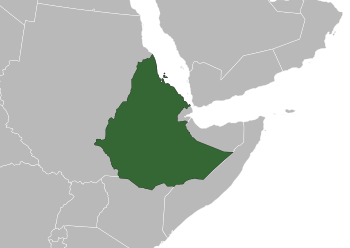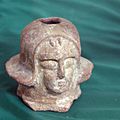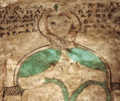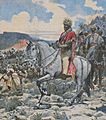Abyssinia facts for kids
The Ethiopian Empire (also called Abyssinia by people from other countries) was a very old and powerful empire. It included the lands of modern-day Ethiopia and Eritrea. At its largest, it even controlled parts of Egypt, Sudan, Yemen, and Saudi Arabia.
This empire was first mentioned in ancient Egyptian records around 980 BC. Its king made Christianity the official religion in the 4th century. The Solomonic dynasty ruled the empire from 1270 AD until 1974. This made it one of the longest-lasting governments in the world. It was also one of only two nations in Africa that was never fully colonized by European powers. In 1974, a group called the Derg took over the government.
Quick facts for kids
Ethiopian Empire
|
|||||||||||||||||||
|---|---|---|---|---|---|---|---|---|---|---|---|---|---|---|---|---|---|---|---|
| 1270–1974 1936–1941: Government-in-exile |
|||||||||||||||||||
|
Motto: ኢትዮጵያ ታበፅዕ እደዊሃ ሃበ እግዚአብሐር
Ityopia tabetsih edewiha habe Igziabiher (English: "Ethiopia Stretches Her Hands unto God") ("Ethiopia Stretches Her Hands unto God") (Psalm 68:31) |
|||||||||||||||||||
|
Anthem:
"ኢትዮጵያ ሆይ ደስ ይበልሽ" (English: "Ethiopia, be happy") |
|||||||||||||||||||

The Ethiopian Empire boundaries in 1952
|
|||||||||||||||||||

The location of the Ethiopian Empire during the reign of Yohannes IV (dark orange) compared with modern day Ethiopia (orange)
|
|||||||||||||||||||
| Capital | Unspecified (1270–1635) Gondar (1635–1855) Magdala (1855–1868) Mekelle (1871–1885) Addis Ababa (1886–1974) |
||||||||||||||||||
| Common languages | Ge’ez Amharic Oromo |
||||||||||||||||||
| Religion |
|
||||||||||||||||||
| Demonym(s) | Endonym: Ethiopian Exonym: Abyssinian (in non-native sources, derived from the Arabic name for the general region "Al-Habash" and the most widely prominent pan-ethnic group the Habesha) | ||||||||||||||||||
| Government | Absolute monarchy | ||||||||||||||||||
| Emperor | |||||||||||||||||||
|
• 1270 (first)
|
Yekuno Amlak | ||||||||||||||||||
|
• 1930–1974 (last)
|
Haile Selassie | ||||||||||||||||||
| Prime Minister | |||||||||||||||||||
|
• 1909–1927 (first)
|
Habte Giyorgis | ||||||||||||||||||
|
• 1974 (last)
|
Mikael Imru | ||||||||||||||||||
| Legislature | Parliament | ||||||||||||||||||
| Senate | |||||||||||||||||||
| Chamber of Deputies | |||||||||||||||||||
|
Predecessor States
Dʿmt
Sultanate of Aussa Federation of Ethiopia and Eritrea Kingdom of Aksum Zagwe dynasty Medri Bahri Land of Punt Ethiopian Empire Kingdom of Shewa Sultanate of Showa Kingdom of Tankish Sharkha Kingdom of Qita'a Kingdom of Nagash Kingdom of Jarin Sultanate of Dawaro Kingdom of Bazin Template:Medieval Horn of Africa Sultanate of Dahlak Kingdom of Belgin Sultanate of Bale Sultanate of Arababni Sultanate of Ifat Sultanate of Harar Ajuran Sultanate Adal Sultanate Kingdom of Garo Kingdom of Kaffa Kingdom of Janjero Adulis |
|||||||||||||||||||
| Historical era | Middle Ages to Cold War | ||||||||||||||||||
|
• Empire established
|
1270 | ||||||||||||||||||
| 1529–1543 | |||||||||||||||||||
|
• Italian Eritrea
|
1890 | ||||||||||||||||||
|
• Constitution adopted
|
16 July 1931 | ||||||||||||||||||
|
• Conquered by Italy (annexed to Italian East Africa)
|
3 October 1935 | ||||||||||||||||||
| 5 May 1941 | |||||||||||||||||||
|
• Admitted to the UN
|
13 November 1945 | ||||||||||||||||||
|
• Coup d'état by Derg
|
12 September 1974 | ||||||||||||||||||
|
• Monarchy abolished
|
21 March 1975 | ||||||||||||||||||
| Area | |||||||||||||||||||
| 1950 | 1,221,900 km2 (471,800 sq mi) | ||||||||||||||||||
| 1974 | 1,221,900 km2 (471,800 sq mi) | ||||||||||||||||||
| Population | |||||||||||||||||||
|
• 1950
|
19,575,000 | ||||||||||||||||||
|
• 1974
|
35,074,000 | ||||||||||||||||||
| Currency |
|
||||||||||||||||||
|
|||||||||||||||||||
| Today part of | |||||||||||||||||||
Contents
History of the Empire
The Ethiopian Empire has a very long and interesting history. It began with the Solomonic dynasty in 1270. This dynasty claimed to be descendants of the biblical King Solomon and the Queen of Sheba.
Early Years and Growth
The first emperor of this new era was Yekuno Amlak. He brought stability to the region after a period of change. The empire grew stronger over the centuries. It developed its own unique culture and traditions.
Important Conflicts
The empire faced many challenges. One major conflict was the Ethiopian-Adal war (1529–1543). This was a long war against the Adal Sultanate. Ethiopia managed to survive this tough period.
Capital Cities
For a long time, the empire did not have one fixed capital city. The emperors often moved their courts.
- From 1635 to 1855, the city of Gondar became the capital. It is famous for its beautiful castles and churches.
- Later capitals included Magdala and Mekelle.
- Finally, Addis Ababa became the permanent capital in 1886. It remains the capital of modern Ethiopia today.
The Zemene Mesafint
Before the mid-1800s, Ethiopia went through a period called the Zemene Mesafint. This means "Era of Princes." During this time, the emperors had less power. Different regional lords fought for control. This period ended when Tewodros II became emperor. He worked to reunite the country.
Resisting Colonization
In the late 1800s, many European countries were taking over parts of Africa. This was called the "Scramble for Africa." Ethiopia was one of the few African nations that successfully resisted being fully colonized.
The Battle of Adwa
A key moment was the Battle of Adwa in 1896. Ethiopian forces, led by Emperor Menelik II, defeated the Italian army. This victory was a huge symbol of African independence. It showed that an African nation could defeat a European power.
Modern Era and End of the Empire
In the 20th century, Ethiopia continued to develop. A new constitution was adopted in 1931. However, Italy invaded Ethiopia again in 1935, starting the Second Italo-Ethiopian War. Italy conquered Ethiopia and made it part of Italian East Africa.
Sovereignty Restored
During World War II, Ethiopia fought back. With help from Allied forces, its sovereignty was restored in 1941. Emperor Haile Selassie returned to power. Ethiopia later joined the United Nations in 1945.
The End of the Empire
The Ethiopian Empire lasted until 1974. In that year, a military group called the Derg took control. They overthrew Emperor Haile Selassie and ended the long-standing monarchy. The monarchy was officially abolished in 1975.
Images for kids
-
An Axumite jar spout
-
A picture of Yekuno Amlak, who started the Ethiopian Empire.
-
Dawit II of Ethiopia (also called Lebna Dengel), an Emperor from the Solomonic dynasty.
-
Emperor Tewodros II helped unite Ethiopia.
-
Menelik II watching the Battle of Adwa where Ethiopia defeated Italy.
-
Haile Selassie was the last Emperor of the Ethiopian Empire.
See Also
 In Spanish: Imperio etíope para niños
In Spanish: Imperio etíope para niños











